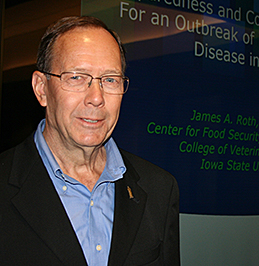
Dr. James Roth, Clarence Hartley Covault Distinguished Professor of Veterinary Microbiology and Preventive Medicine, has been elected to the National Academy of Medicine for decades of work studying infectious diseases.
He is the first faculty member from the College of Veterinary Medicine to gain membership in the National Academy of Medicine. Roth serves as director of the Center for Food Security and Public Health and executive director of the Institute for International Cooperation in Animal Biologics. He’s devoted much of his career to studying the immunology of infectious diseases of livestock and management of foreign animal disease outbreaks.
“To have two Iowa State faculty elected to the National Academy of Medicine is an outstanding achievement,” said Iowa State President Steven Leath. “It is a well-deserved recognition of Dr. Carriquiry’s and Dr. Roth’s commitment to service and advancing research in their fields,” Leath said.
Roth grew up on a farm near Hartwick in east-central Iowa and earned a doctorate of veterinary medicine and a Ph.D. in veterinary microbiology from Iowa State. He spent two years practicing veterinary medicine before returning to Iowa State as a faculty member in 1977. Since then, he’s testified before Congress on agroterrorism and foreign animal disease preparedness and served on federal advisory panels and committees for the National Research Council of the National Academies of Science.
“I am especially proud of receiving this recognition after having received all of my education and spending my entire career in Iowa,” Roth said. “I benefited from being part of an excellent land-grant institution, a college of veterinary medicine with a strong tradition of excellence in infectious diseases of food animals and the opportunity to collaborate with the U.S. Department of Agriculture National Centers for Animal Health in Ames.”
Following 9/11, Roth established the Center for Food Security and Public Health to develop strategies dealing with the potential of agro-terrorism and other threats to livestock production and the U.S. food supply. Since then, the center’s mission has shifted more to responding to exotic and foreign diseases. The center has played an instrumental role in working with USDA, state animal health officials and industry to revise plans on how to deal with devastating animal disease outbreaks through development of secure food supply plans.
The center received funding from USDA to develop a course on emerging and exotic diseases for animals now available to every veterinary college in the country. The center also received USDA funding to develop and deliver required continuing education for 60,000 USDA-accredited veterinarians in the U.S. Much of the center’s work has implications for human health, especially recognition and prevention of zoonotic diseases that transfer from animals to people.
“I have been fortunate to have an amazing team of professionals working with me in the center,” Roth said.
Roth is among 70 new members and nine international members inducted into the academy this year. The National Academy of Medicine works together with the National Academy of Sciences and National Academy of Engineering to provide independent, objective analysis and advice to the nation and conduct other activities to solve complex problems and inform public policy decisions.
The academies also encourage education and research, recognize outstanding contributions to knowledge, and increase public understanding in matters of science, engineering, and medicine.
October 2016
